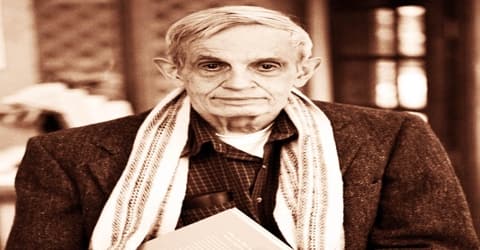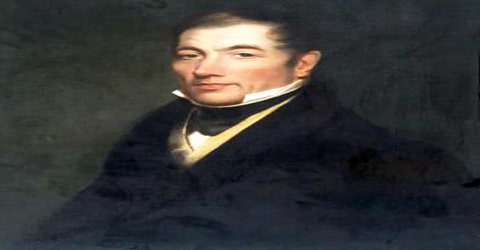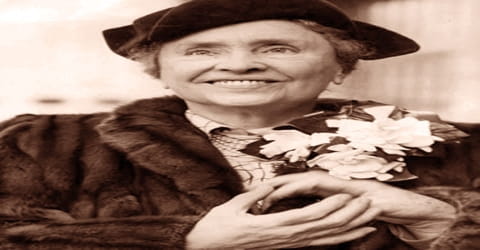Biography of John Forbes Nash Jr.
John Forbes Nash Jr. – American mathematician.
Name: John Forbes Nash Jr.
Date of Birth: June 13, 1928
Place of Birth: Bluefield, West Virginia, U.S.
Date of Death: May 23, 2015 (aged 86)
Place of Death: Monroe Township, Middlesex County, New Jersey, U.S.
Occupation: Mathematician
Father: John Forbes Nash
Mother: Margaret Virginia Martin
Spouse/Ex: Alicia Lardé Lopez-Harrison (m. 1957)
Children: John Charles Martin Nash, John Stier
Early Life
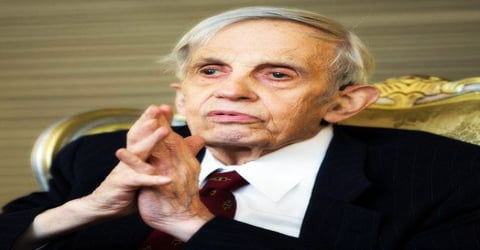
An American mathematician who was awarded the 1994 Nobel Prize for Economics for his landmark work, first begun in the 1950s, on the mathematics of game theory, John Forbes Nash, Jr. was born on June 13, 1928, in Bluefield, West Virginia, the U.S. He did massive work in many branches of mathematics and his theories have proven to be very useful in numerous fields such as market economics, computing, biology, artificial intelligence, politics, and accounting. He shared the prize with John C. Harsanyi and Reinhard Selten. In 2015 Nash won (with Louis Nirenberg) the Abel Prize for his contributions to the study of partial differential equations.
Having graduated from esteemed educational establishments like the ‘Carnegie Institute of Technology’ and the ‘Princeton University’, he revolutionized the field of equilibrium theory. He is famous for his works on ‘Game Theory’, partial differential equations, and algebraic geometry. Not only is this mathematician’s work important in his field of study, but is also used in a wide range of subjects like artificial intelligence, politics, economics, accounting, and even biology. Application of his ‘Game Theory’ is essential for arriving at decisions that benefit an organization and its people. Since the establishment of the validity of this field of study, eleven game theorists have been awarded the ‘Nobel Prize’. Though glorified by his biographer, Sylvia Nasar, and Hollywood, his life has been controversial, where he has been charged with indecent conduct and has allegedly not been a very able husband and father. However, it is this talented mathematician’s fight against schizophrenia and the stigma associated with the condition, which has made him the epitome of brilliance according to many, across the world.
John Nash is the only person to be awarded both the Nobel Memorial Prize in Economic Sciences and the Abel Prize. In 1959, Nash began showing clear signs of mental illness and spent several years at psychiatric hospitals being treated for paranoid schizophrenia. After 1970, his condition slowly improved, allowing him to return to academic work by the mid-1980s. His struggles with his illness and his recovery became the basis for Sylvia Nasar’s biography, A Beautiful Mind, as well as a film of the same name starring Russell Crowe as Nash.
Childhood, Family and Educational Life

John Nash, in full John Forbes Nash, Jr., was born in the town of Bluefield, West Virginia, the U.S. on June 13, 1928. His father, John Forbes Nash, was an electrical engineer for the Appalachian Electric Power Company. His mother, Margaret Virginia (née Martin) Nash, had been a schoolteacher before she was married. He was baptized in the Episcopal Church. He had a younger sister, Martha (born November 16, 1930), who was born approximately two and a half years later.
John Nash attended kindergarten and public school, and he learned from books provided by his parents and grandparents. Nash’s parents pursued opportunities to supplement their son’s education and arranged for him to take advanced mathematics courses at a local community college during his final year of high school. He attended Carnegie Institute of Technology (which later became Carnegie Mellon University) through a full benefit of the George Westinghouse Scholarship, initially majoring in chemical engineering. Nash switched to a chemistry major and eventually, at the advice of his teacher John Lighton Synge, to mathematics. After graduating in 1948 (at age 19) with both a B.S. and M.S. in mathematics, Nash accepted a scholarship to Princeton University, where he pursued further graduate studies in mathematics.
John Nash earned a ‘John S. Kennedy scholarship’ to the prestigious ‘Princeton University’, where he specialized in the equilibrium theory in mathematics. In 1950, the young man was able to graduate with a doctorate degree for his research on ‘non-cooperative games’. During this time, he published dissertation papers like ‘Equilibrium Points in N-person Games’, ‘The Bargaining Problem’, and ‘Non-cooperative Games’.
In 1951 he joined the faculty of the Massachusetts Institute of Technology (MIT), where he pursued research into partial differential equations. He resigned in the late 1950s after bouts of mental illness. He then began an informal association with Princeton, where he became a senior research mathematician in 1995.
This American mathematician had a choice between ‘Harvard University’, and the ‘Princeton University’, to pursue his higher education, but he chose the latter because they offered him a scholarship. This proved to this man that the ‘Princeton University’ thought he had potential, and valued him more.
Personal Life
In 1952, John Forbes Nash, Jr. began a relationship in Massachusetts with Eleanor Stier, a nurse he met while admitted as a patient. They had a son, John David Stier, but Nash left Stier when she told him of her pregnancy. The film based on Nash’s life, A Beautiful Mind, was criticized during the run-up to the 2002 Oscars for omitting this aspect of his life. He was said to have abandoned her based on her social status, which he thought to have been beneath him. Two years later, in 1954 he was arrested in California, for his homosexual encounters in a public toilet. He was released from prison soon, but the exceptional mathematician lost his job at the ‘RAND Corporation’.
In February 1957, John Nash got married to a physics graduate from ‘MIT’, Alicia Lopez-Harrison de Lardé, according to Roman Catholic customs and the couple had a son, John Charles Martin. Soon John started developing symptoms of mental illness, and authorities at the ‘McLean Hospital’ diagnosed him with schizophrenia. Nash was later institutionalized at the ‘New Jersey State Hospital’, and from then on was treated regularly for the disease. Due to the stress of dealing with his illness, Nash and Lardé divorced in 1963.
John Nash’s schizophrenia started somewhere during 1957. His behavior was explained by his wife as unpredictable. He would talk about characters that didn’t exist and feared that all those men with red ties were against him in a conspiracy. He went as far as writing letters to D.C that those men were to form a government. Nash was diagnosed with paranoid schizophrenia by the doctors of McLean hospital in May 1959. Consequently Nash resigned from his post at MIT, withdrawing his pension and went to Europe. After a disturbing chain of events with him getting arrested by the police in Paris, he was sent back to the United States. He took treatment from many hospitals where he got antipsychotic medicines.
After his final hospital discharge in 1970, John Nash lived in Lardé’s house as a border. This stability seemed to help him, and he learned how to consciously discard his paranoid delusions. He stopped taking psychiatric medication and was allowed by Princeton to audit classes. He continued to work on mathematics and eventually was allowed to teach again. In the 1990s, Lardé and Nash resumed their relationship, remarrying in 2001.
The 1998 biography of this great mathematician, ‘A Beautiful Mind’ was penned by Sylvia Nasar. Three years later, the book became the basis for filmmaker Ron Howard’s movie, having the same title. The movie, ‘A Beautiful Mind’ starred American actor Russell Crowe as Nash, and won several accolades, including the ‘Academy Award for Best Picture’.
Career and Works
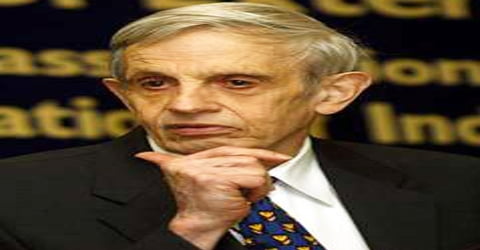
While he was still in graduate school, John Forbes Nash, Jr. published (April 1950) his first paper, “The Bargaining Problem,” in the journal Econometrica. He expanded on his mathematical model for bargaining in his influential doctoral thesis, “Non-Cooperative Games,” which appeared in September 1951 in the journal Annals of Mathematics. Nash thus established the mathematical principles of game theory, a branch of mathematics that examines the rivalries between competitors with mixed interests. Known as the Nash solution or the Nash equilibrium, his theory attempted to explain the dynamics of threat and action between competitors. Despite its practical limitations, the Nash solution was widely applied by business strategists.
In 1952, John Nash published his work on other areas of mathematics, in the paper, ‘Real algebraic manifolds’. The following year, the thesis paper, ‘Two-person Cooperative Games’, based on his research conducted at ‘Princeton University’ was also published. While working on a problem related to German mathematician David Hilbert’s ‘elliptic partial differential equations’, John got acquainted with Italian, Ennio de Giorgi in 1956. Both Nash and Giorgi formulated the proof for the equation, a few months away from each other, and thus both missed out on the ‘Fields Medal’.
Although John Nash’s mental illness first began to manifest in the form of paranoia, his wife later described his behavior as erratic. Nash seemed to believe that all men who wore red ties were part of a communist conspiracy against him. He mailed letters to embassies in Washington, D.C., declaring that they were establishing a government. Nash’s psychological issues crossed into his professional life when he gave an American Mathematical Society lecture at Columbia University in 1959. Originally intended to present proof of the Riemann hypothesis, the lecture was incomprehensible. Colleagues in the audience immediately realized that something was wrong. He was admitted to McLean Hospital in April 1959, staying through May of the same year. There, he was diagnosed with paranoid schizophrenia.
In 1958, John Nash began working as a lecturer on a probationary term, at the ‘MIT’. By the following year, his work started getting hampered owing to symptoms of mental illness, which became quite evident after his incoherent speech at the ‘American Mathematical Society’ of ‘Columbia University’.
In 1961, Nash was admitted to the New Jersey State Hospital at Trenton. Over the next nine years, he spent periods in psychiatric hospitals, where he received both antipsychotic medications and insulin shock therapy.
After a long period of hospitalization, John Nash was able to continue work since 1970, the year he refused to be treated any further for his schizophrenia. Within the next ten years, he overcame his regular hallucinations and was able to concentrate completely on academic research. Towards the end of his career, he worked at the ‘Princeton University’, as a Senior Research Mathematician.
Nash’s research into differential equations at MIT led to his seminal paper “Real Algebraic Manifolds,” which was published in Annals of Mathematics in November 1952. His other influential work in mathematics included the Nash-Moser inverse function theorem, the Nash–De Giorgi theorem (a solution to David Hilbert’s 19th problem, which Nash undertook at the suggestion of Nirenberg), and the Nash embedding (or imbedding) theorems, which the Norwegian Academy of Science and Letters described as “among the most original results in geometric analysis of the twentieth century”; the academy awarded Nash the Abel Prize. His other honors included the John von Neumann Theory Prize (1978) and the American Mathematical Society’s Leroy P. Steele Prize for a Seminal Contribution to Research (1999).
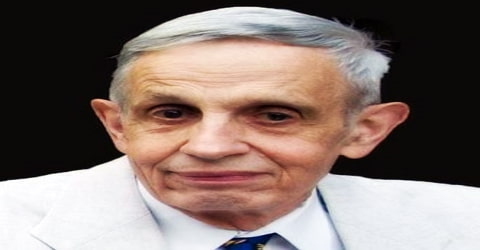
In 2005, John Nash delivered a speech at the ‘Warwick Economics Summit’, hosted by the ‘University of Warwick’. In 2006, Nash also attended a conference at Cologne, one of Germany’s largest cities, where he spoke about strategic decision making using his ‘Game Theory’. In recent times, Nash had conducted extensive studies in the field of game theory and partial differential equations.
Awards and Honor
This ingenious mathematician was felicitated with the 1978 ‘John von Neumann Theory Prize’, for pioneering the ‘non-cooperative equilibrium’, which has now been named after him, as the ‘Nash equilibrium’.
In 1994, this accomplished mathematician received the ‘Nobel Prize’, in the field of ‘Economic Sciences’, for his work on ‘Game Theory’. John Nash shared the award with German Economist, Reinhard Selten, and Hungarian-American scholar, John Harsanyi.
The ‘Leroy P. Steele Prize’ was awarded to John Nash in the year 1999, for his invaluable contribution to the field of mathematics.
In 2010, John Nash received the ‘Double Helix Medal’ by the ‘Cold Spring Harbor Laboratory’, for his fight against schizophrenia.
In 2012, John Forbes Nash Jr. was elected as a fellow of the American Mathematical Society. On May 19, 2015, a few days before his death, Nash, along with Louis Nirenberg, was awarded the 2015 Abel Prize by King Harald V of Norway at a ceremony in Oslo.
Death and Legacy
On May 23, 2015, John Forbes Nash Jr. and his wife died when a taxi they were riding in lost control and crashed on the New Jersey Turnpike. He was 86. He is survived by his son John Charles Martin Nash who lived with his parents at the time of their death.
Following his death, obituaries appeared in scientific and popular media throughout the world. In addition to their obituary for Nash, The New York Times published an article containing quotes from Nash that had been assembled from media and other published sources. The quotes consisted of Nash’s reflections on his life and achievements.
Amongst all mathematical research conducted by this genius, the one that brought him fame, and the ‘Nobel Prize’, is his work on ‘Game Theory’. The ‘Game Theory’ has become a significant area of study in the field of economics, and it describes how participants of a game take decisions individually or collectively to arrive at a win-win situation.
Nash’s research into game theory and his long struggle with paranoid schizophrenia became well known to the general public because of the Academy Award-winning motion picture A Beautiful Mind (2001), which was based on Sylvia Nasar’s 1998 biography of the same name. A more factually accurate exploration of Nash’s struggle with mental illness was offered by the public television documentary A Brilliant Madness (2002).
John Nash also received an honorary degree, Doctor of Science and Technology, from Carnegie Mellon University in 1999, an honorary degree in economics from the University of Naples Federico II on March 19, 2003, an honorary doctorate in economics from the University of Antwerp in April 2007, an honorary doctorate of science from the City University of Hong Kong on November 8, 2011, and was keynote speaker at a conference on game theory.
Information Source:
